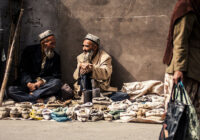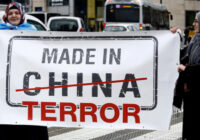After a seven-year break, I joined a small group of Chinese researchers last fall in their visit of four cities in Xinjiang: Kashgar, Aksu, Kuche, Bayi and Urumqi. The far-western region of Xinjiang is home to China’s mostly Muslim Uyghur minority. The main purpose of the visit was to get a glimpse into the Uyghurs’ daily lives and, in particular, assess whether their lives were adversely affected by what the West claims to be excessive security measures and a de facto ban of the Uyghur language. While most of our 7-day trip and meetings were supervised, there were numerous opportunities to observe Uyghurs going about their lives and improvise a number of conversations with them.

Given the time and access restrictions, this article does not intend to enter the discussion of whether Chinese policies in Xinjiang can be considered “cultural genocide” or if there is forced labor in the region. Neither does this article intend to explain why no women were seen to wearing the hijab, or the fact that only very few older men were seen to attend prayers. These radical changes can hardly be explained by natural and voluntary internal changes in the Uyghur community, but an objective assessment of these issues is not feasible with the available information. However, the information collected during the 7-day visit is sufficient to assess the validity of claims made by Western scholars and media regarding strict restrictions imposed on the use Uyghur language and the ubiquitous presence of security checkpoints in the region.
Where are all the checkpoints?
The Council on Foreign Relations, a reputed American think tank, states that, “In some cities, such as western Xinjiang’s Kashgar, police checkpoints are found every one hundred yards or so.” Under the headline, “The Police Region of Xinjiang: Checkpoints, Camps, and Fear,” the author declares that “an Uyghur I know was stopped 34 times one day.” In a similar vein, the Uyghur Academy states that “Each square has a police station that closely monitors inhabitants by regularly scanning their identification cards, taking their photographs and fingerprints, and searching their cell phones.” The New York Times’ piece “How China Uses High-Tech Surveillance to Subdue Minorities” affirms that “the online records indicate that a network of about 10,000 checkpoints in Urumqi made more than six million identifications in 24 hours.”
These statements about security checks in Xinjiang are either outdated or grossly inflated.
Indeed, what struck me the most on our first day in Kashgar was the total absence of checkpoints and paramilitary patrols on the roads and streets, which had been common during my last visit to the region in 2016. After landing in Kashgar, we drove to our hotel downtown and went to one of Kashgar’s night markets. To my surprise, there were no checkpoints at all, neither for traffic nor for pedestrians. In the following two days, we crisscrossed the city and went to the countryside several times. Not a single time had we to go through a checkpoint or saw anyone having to do so, no checkpoints or police patrols were visible and police presence on the streets was minimal. We only spotted one police van in a park where there was a large congregation of people dancing and a few traffic police cars on the roads. Moreover, this absence checkpoints continued for the whole 7-day trip to Kashgar, Aksu, Kuche and Urumqi, during which did not encounter or see a single checkpoint.

So, at least in these four cities, there were no visible checkpoints and the police presence was minimal. The general atmosphere in the streets was relaxed, which was in itself a positive change from the situation we saw seven years ago, when interethnic tensions were obvious and extensive security measures were visible. Over the entire period of our visit, we didn’t see any security checkpoints at all and didn’t witness anyone having his ID checked in the streets, strongly undermining the Western media’s claim that checkpoints are omnipresent in Xinjiang.
Language issues
Another controversial issue discussed extensively in the Western media is that the use of the Uyghur is extremely restricted in Xinjiang. The United Nations Human Rights assessment from August 2022 found that some Uyghurs and Kazakhs “were not allowed to speak their own language.” The Uyghur Human Rights Project’s brief January 2019 piece “Assault on the Uyghur Language in East Turkestan” stated that “official policies discourage speaking and writing in Uyghur in public” and that “shops must clear the shelves of anything written in Uyghur script and Uyghur scrubbed from street signs and signboards.”
The first hint that made me question the validity of these statements was the fact that the announcements on the plane from Urumqi to Kashgar were made in three languages: Mandarin, Uyghur and English. After landing in Kashgar, most signs in the airport were in Uyghur too. And most Uyghurs spoke to each other in Uyghur. While driving from the airport to the city, we tuned into different programs on the radio and we found that approximately half of them were in Mandarin and half in Uyghur. In the following days, we stayed in several hotels and the local TV programs were also half in Mandarin and half in Uyghur.
Street and store signs were always written in Chinese characters and most of them had Uyghur, too. The font of the Chinese characters was larger, and sometimes the Uyghur script was not shown or not illuminated at night. From the observations I made over the 7-day trip, I gathered that signs are required to be written in Chinese characters and that people have the choice to add the Uyghur version. In predominantly Uyghur areas, the Uyghur script was practically always added.

Most Uyghurs talked to each other in the Uyghur language on the streets, in restaurants, aboard planes and in the countryside. School-aged children talked to each other in both Uyghur and Mandarin. It is relevant to mention that two of the Uyghurs we talked to (aged 30–40 years old) were unable to maintain a conversation in Mandarin, indicating that they had not spent time in the “vocational schools” or “camps.” Numerous Uyghurs we talked to had still very limited command of the Mandarin language.
Uyghur might not be taught in schools, but it seems to be the dominant language used among Uyghurs, both young and old, and the large majority of the signs seen were both in Uyghur and Chinese. Hence, the restrictions on the use of the Uyghur language are also grossly overstated in the West. Also, we didn’t see any indications that the use of the Uyghur language was restricted.
It is important that Western media and scholars adjust their claims to the current realities in Xinjiang, otherwise, they will strongly undermine their efforts to provide a credible perspective of the living conditions of the Uyghurs in Xinjiang.
[Anton Schauble edited this piece.]
The views expressed in this article are the author’s own and do not necessarily reflect Fair Observer’s editorial policy.
Support Fair Observer
We rely on your support for our independence, diversity and quality.
For more than 10 years, Fair Observer has been free, fair and independent. No billionaire owns us, no advertisers control us. We are a reader-supported nonprofit. Unlike many other publications, we keep our content free for readers regardless of where they live or whether they can afford to pay. We have no paywalls and no ads.
In the post-truth era of fake news, echo chambers and filter bubbles, we publish a plurality of perspectives from around the world. Anyone can publish with us, but everyone goes through a rigorous editorial process. So, you get fact-checked, well-reasoned content instead of noise.
We publish 2,500+ voices from 90+ countries. We also conduct education and training programs
on subjects ranging from digital media and journalism to writing and critical thinking. This
doesn’t come cheap. Servers, editors, trainers and web developers cost
money.
Please consider supporting us on a regular basis as a recurring donor or a
sustaining member.
Will you support FO’s journalism?
We rely on your support for our independence, diversity and quality.








Comment